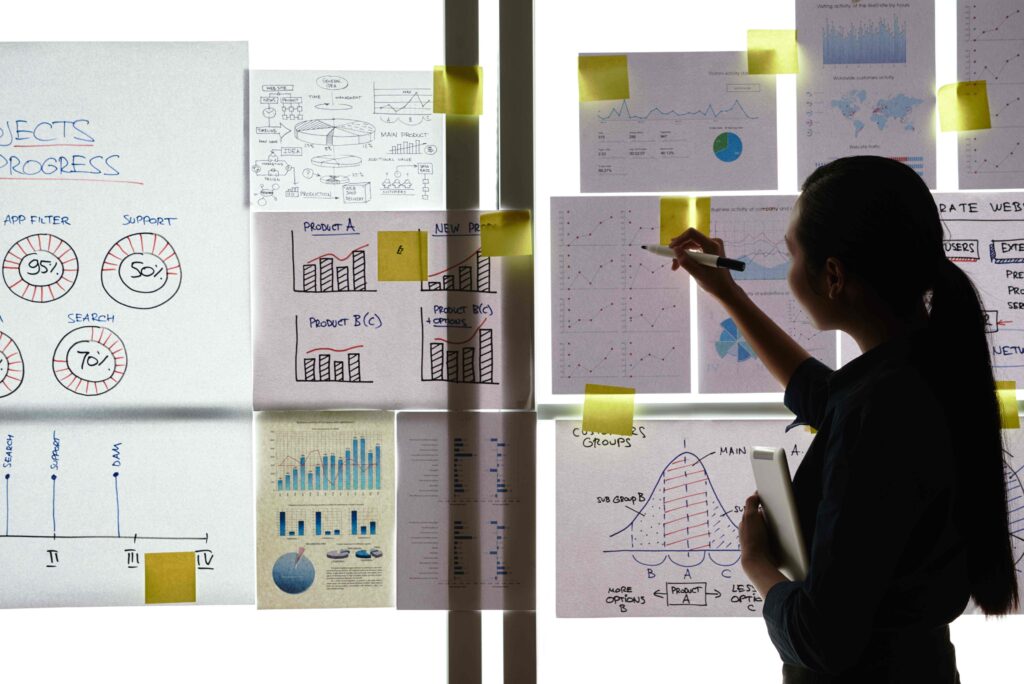Learn the fundamentals of project management with this comprehensive guide
Overview of Project Management Basics
PMI (Project Management Institute) reports a serious risk of a talent gap between the growing demand for project managers and the amount of trained project managers that can fill those roles. As stated in a 10-year employment trends report by PMI, “The global economy needs 25 million new project professionals by 2030. To close the talent gap, 2.3 million people will need to enter PMOE [project management-oriented employment] every year just to keep up with demand.”
Every organization, whether a business or a non-profit, must execute projects—making project management critical to ensuring project success. This applies to various contexts, from boosting efficiency in a healthcare facility to salvaging important client relationships. Project managers play a key role in steering project delivery, skillfully handling the project’s scope of work, timeline, budget, and stakeholders at every stage. The versatile nature of project management skills makes them valuable across nearly any sector, from healthcare to construction, IT, and beyond.
In this guide, we’ll explore the basics of project management, from its core components and the five stages of the project management life cycle to essential skills and tools that drive project success. With a blend of training and education, hands-on experience, and both technical and soft skills, you can establish a rewarding career in project management—regardless of your starting point. Learn how to become an indispensable asset to your current or future organization with this comprehensive introduction to project management basics.
What is Project Management?
Project management involves more than just directing projects. According to the Association for Project Management (APM), it’s “The application of processes, methods, skills, knowledge and experience to achieve specific project objectives.” At its core, a project manager establishes timelines, manages budgets, coordinates team efforts, and communicates with stakeholders to ensure that all project goals are met successfully.
To drive project success, a project manager must create and present key documents like project charters, detailed project plans, and budgets to both internal team members and external stakeholders. This process ensures everyone understands the project’s objectives and the roadmap for achieving them.
Core Components of Project Management
There are four core components of project management to understand:
- Project Charter
The project charter is an essential document that lays the foundation for a successful project. This outlines the key aspects of a project plan from project objectives and scope to stakeholders and overall framework. According to ProjectManager.com the project charter, “Helps guarantee clarity, alignment, and accountability to contribute to its success.”
- Project Plan
The project plan defines the overall strategy for executing a project, including essential elements of a project schedule like goals, timelines, deliverables, risk assessment, stakeholders, and resources. Project planning helps all team members and stakeholders understand processes, responsibilities, and goals.
- Project Budget
The project budget is vital in tracking expenses and keeping the project on budget. This is one of the most crucial elements in the successful delivery of a project. The project budget, “Consists of direct and indirect costs, fixed and variable costs, revenue, and contingencies,” According to ProjectManager.com.
- Stakeholders and Teams
Occasionally, project managers are in charge of assembling their own project team. This team may include a project coordinator, project sponsor, business analyst, and individual subject matter experts (SMEs) like software engineers, copywriters, graphic designers, and more. Project stakeholders include a broad scope of people, taking on many different shapes and sizes in the form of internal team members and external customers, suppliers, government entities, and more.
The Project Management Life Cycle
Every project management framework, regardless of the project type, follows a similar process known as the project management life cycle, which includes a clear beginning, middle, and end. This cycle consists of five essential stages, each playing a crucial role in ensuring efficient project execution and on-time delivery. Here is a brief overview of all the stages in order:
- Initiation
Initiation is the first phase of the project management life cycle. In this phase, a project manager is responsible for defining the project, developing a business case for it, and getting it approved by stakeholders. In the opinion of Wrike, during this time, “The project manager should have a high-level understanding of the project’s purpose, goals, requirements, and risks.”
- Planning
The planning phase is when project managers create a project roadmap where all team members can follow along. The project roadmap outlines project progress through goals and deliverables based on requirements laid out by the customer or organization. Wrike suggests that, during this time, project managers should develop a project plan, create a resource plan, define performance measures, build out workflows, and more.
- Execution
This is where the planning ends and the heavy lifting begins. At this point, all stakeholders and team members should know who is responsible for what, what they are doing and why, which communication channels and tools are to be used, and more.
- Monitoring and Control
This phase works in tandem with the execution phase—think of two roads running parallel heading in the same direction. If there are roadblocks, or if one car is moving in the opposite direction of another, project managers will help guide traffic so that all drivers are traveling smoothly in the same direction. During this time, project managers are responsible for resource management, risk management, updating the project schedule, and conducting project status meetings.
- Closing
Although the bulk of the work is done for the team as a whole at this stage, the project closure phase is where critical elements of being a project manager are showcased. This is the wrap-up phase, a time for project managers to take inventory, tie up any loose ends, and deliver the finished project to clients and stakeholders. After the hand-off, project managers will typically host a post-mortem with the team to discuss success stories as well as learning opportunities.
Project Management Methodologies
Understanding project management methodologies is crucial in learning project management basics. Adobe defines a project management methodology as, “A set of tools and guidelines that help you organize projects in a way that optimizes efficiency and performance.” So, what methodologies are out there? Among the sea of popular methodologies, here are the top three you should know, with their most effective usage.
Waterfall
The traditional, more rigid, Waterfall method adopts a linear approach to project management. In this method, project management phases “cascade” into the next, creating a dependency of phases—meaning one phase cannot begin until the previous has been completed. Because this project management methodology is focused on team collaboration (one phase cannot be initiated without its predecessor), Adobe says this is, “Best suited for large teams working on big projects involving multiple clients and stakeholders.”
Agile
Conversely, Agile project management is a much more fluid approach than Waterfall. Agile project management is a principle that centers around agility, speed, collaboration, and iterative processes. Creative teams, such as marketing, may benefit most from this principle. To showcase the flexibility of this method, you’ll often see teams using a hybrid approach, combining Agile with other principles like Kanban and Scrum. In our 10-week Project Management Certificate Course, in partnership with Ziplines Education, you’ll learn the key principles of Agile project management and how to create an Agile project plan in Jira using both a Kanban and Scrum approach. Speaking of which…
Kanban
For visual learners, the most effective project management method utilizes Kanban boards and cards to plan, schedule, and track work. This is an organized visual representation of project progress. Adobe claims, “Agile teams frequently use the Kanban framework to track project progress and avoid bottlenecks.” Although you’ll typically see this method used by teams in manufacturing or software development, it can really be used by any team—especially those that have a remote or hybrid work environment.
Scrum
As an effective project management framework, “The essence of Scrum is a self-organizing team delivering customer value in a time-boxed period called a Sprint,” according to Amazon. This framework highlights adaptability and change as well as self-management as the team as a whole works towards a common goal. Just as Kanban is used along with Agile principles, so is Scrum.
Tools and Software in Project Management
Tools and software used in project management is crucial to a team’s overall project success. Let’s take a look at the popular project management software and collaboration tools that project management teams rely on.
Project Management Collaboration Tools:
- Slack: Used for team communication and project management, Slack is one of the most commonly used collaboration and project management tools in the U.S. According to Slack’s internal data usage analysis, “80% of the Fortune 100 use Slack Connect to work with partners and customers.”
- Zoom: If you’re not already familiar with Zoom, it’s one of the leading communication technology companies in the country. Zoom offers a secure video conferencing platform that’s widely used by virtual project teams in a myriad of professions.
- Jira: Primarily used for bug and issue tracking, as well as Agile project management, Jira is utilized on a global scale. Project managers use this software development tool to track, manage, and release projects. Our Project Management Certificate Course, in partnership with Ziplines Education, will prepare you for the Jira Software Essentials exam so you can get certified and show off your agile framework skills on your resume.
Project Management Software:
- Microsoft Project: A powerful yet flexible and simple project management tool created by Microsoft to help plan projects, track project progress, and deliver multiple projects—from small, one-time projects to larger initiatives.
- Asana: A project management tool that is best used to manage company-wide objectives, plans, and strategies. Asana is primarily used to automate cross-departmental workflows.
- Trello: This Kanban-style app is a visual work management tool primarily used for collaborative teams to ideate, manage tasks, and track project progress.
Key Skills for Effective Project Management
- Leadership and Communication: Project management requires exceptional leadership and communication skills. In your role as a project manager, you’ll lead diverse teams of subject matter experts (SMEs), applying your leadership abilities to keep projects on schedule and inspire team members to achieve key milestones. When challenges or disagreements occur, you’ll step in to mediate and resolve conflicts, fostering collaboration and teamwork. Additionally, as the primary project overseer, you’ll communicate across departments, connecting with team members, stakeholders, customers, and others. Throughout the project’s life cycle, you’ll provide essential guidance to your team and regularly update stakeholders on progress.
- Risk and Change Management: Project managers are tasked not only with guiding teams and outcomes but also with identifying and managing project risks. This proactive approach helps them prevent disruptions in workflow, keeping the project aligned with its objectives. Risks encompass anything that might impact the budget, timeline, or overall performance. Change management, on the other hand, deals with major shifts—such as introducing new software or systems into a well-established work environment. Project managers rely on strong communication skills and project management methodologies to minimize productivity disruptions, ensuring that all employees and stakeholders are informed, prepared, and trained in the new system or software.
- Time and Resource Management: Effective time and resource management are essential indicators of project success. As a project manager, an inability to prioritize effectively can impact your team’s performance and jeopardize the project’s completion. Your team will depend on you to help them meet their deadlines, which requires a high level of time management expertise throughout each project phase. Project management software can be invaluable here; leveraging these tools and their specific features is crucial for supporting both your team and achieving the project goal.
Project Management Certification and Training
- Project Management Professional (PMP)® certification: Administered by PMI, this project management certification acknowledges that you have taken the steps, put in the hours, and exceeded expectations to become a certified project manager. Upon completion, you’ll be able to enhance your credibility as a certified project manager—demonstrating your expertise in project leadership, risk management, project management methodologies, and more, to future employers.
- PMI Agile Certified Practitioner (PMI-ACP)®: Also administered by PMI, this certification showcases your Agile project management expertise, including Scrum, Lean, and Kanban project management.
- PRINCE2 training courses: PRINCE2® (Projects IN Controlled Environments) is an internationally recognized, process-based methodology that utilizes a controlled and organized start, middle, and end for project life cycles. The PRINCE2 training consists of two pieces, starting at the foundational level and building up to the “practitioner” level.
- PRINCE2 also offers a PRINCE2 Agile® certification. This combines the framework of PRINCE2 with the flexibility of Agile methodologies.
Our flexible, on-demand Project Management Certificate Course, in partnership with Ziplines Education, is delivered over a 10-week period. Through this mentor-guided program, you’ll gain practical skills in creating a comprehensive project management plan using key tools like Jira, Microsoft Project, and more. By the end of the course, you’ll have developed a Project Management Playbook, showcasing your expertise to potential employers.
Conclusion: The Path to Successful Project Management
This covers the basics of project management—from the foundational components of a successful project to the essential skills, software, and training needed to excel as a project manager. By now, you should have a clear understanding of what project managers do and the significant value they bring to organizations of all kinds.
Take the Next Step in Your Project Management Journey
Our Project Management Certificate Course, in partnership with Ziplines Education, provides you with the core principles and knowledge required to succeed in this dynamic field. With personalized mentorship and a flexible learning format, this program supports you at every stage in your path toward a project management career. For those interested in exploring additional training options, check out our beginner’s guide to project management training programs here.
Remember, a career in project management means a lifetime of learning, adjusting, broadening, and fine-tuning your skills. You’re on the path to a rewarding career. Start today by enrolling in a training program, and step into a high-paying, fulfilling career in project management.




